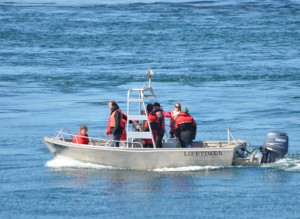Weather and Sea Conditions
There was thick fog in the morning and it took longer to clear than yesterday. The fog bank which came in from the west coast was more extensive today. According to a scout who called from the top of Mount Finlayson, the fog extended down towards Seattle and up through Haro Strait. By early afternoon, there were clear blue skies and sunshine. Wind was light and variable picking up from the west at sunset, to 15 -20 knots. Sea conditions were calm other than the large tidal movements, which make it rough in the narrow and constricted areas.
It was sunny enough once the fog lifted, that the UV index reached a high of 5 (moderate). Barometric pressure stayed fairly steady at about 1005 hPa. There is a strong wind warning in effect on the marine forecast for the Central Juan de Fuca Strait and the forecast calls for westerly winds of 10 to 15 knots increasing to westerly 20 to 30 early Sunday afternoon.
Vessel Observations
No whale-watching vessels were observed working in the protected area today. Transient (Bigg’s) Killer Whales elsewhere kept them busy. Several sports fishing boats went through the reserve, slowly and respectfully.
Kyle, the new Pearson College foreshore person, brought visitors out for a tour around the reserve in Haiku, but did not land.
Ecological and General Observations
Now there are five young, male, Northern Elephant Seals ashore on Great Race. They are just starting moult on their faces, around their mouths. They spend most of their time asleep in the garden but squidgle down to the water for a swim in the afternoon, taking their time coming and going. I saw the Steller’s Sea Lion 433Y again today on South Rock. The two species of sea lion seem to be separating out from each other a little more, with better defined separation of haul-outs.
Three pairs of Canada Geese that we had been keeping off the island, took advantage of the cover of yesterday’s wind to move in. The males are very belligerent and aggressive enough that they are going to be difficult to move. This could be fun.
Other birds that continue their pair bonding and nesting rituals include the Black Oystercatchers, Pigeon Guillemotts and Glaucous-winged Gulls. The Black Turnstones may be getting ready to migrate, as they seem to be taking flight together more than usual, going for wheeling spins off the island. They move very quickly and together as a living unit, flashing their black and white in flights away and then back to the reserve. The Bald Eagles continue to roost and hunt, seemingly all day, everyday.
Sunlight levels were high enough to generate extra electricity for laundry and making fresh water, with the de-salinator, in spite of thick fog until early afternoon.
Chores were routine. There were no visitors.
